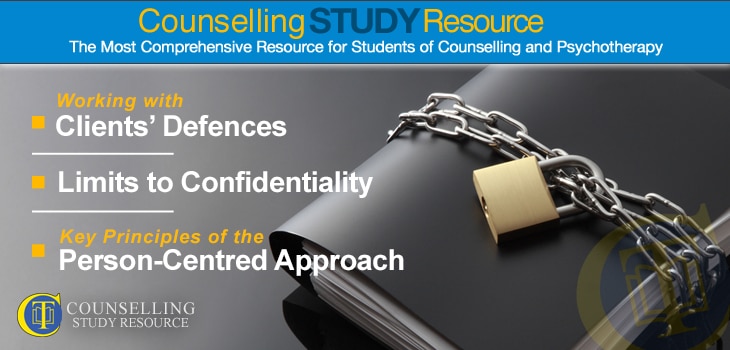In episode 76 of the Counselling Tutor Podcast, Ken Kelly and Rory Lees-Oakes discuss how to spot and work with clients’ defences. ‘Practice Matters’ then investigates the limits to confidentiality in counselling. Finally, the presenters discuss the key principles of the person-centred approach.
Working with Clients’ Defences (starts at 2.20 mins)
While we all know our own truth (unless our reality is altered – for example, by drugs, alcohol or psychosis), we sometimes defend ourselves from looking at this – perhaps for fear that it may be too painful or difficult. This ‘block’ can really feel like a brick wall.
You may see this phenomenon in clients who say they want to change something, yet at the same time seem very resistant to actually doing so. It can be difficult to know how best to deal with this as a therapist: should we challenge, or should we simply wait for the client to become ready?
The clue here lies in numbers 16 and 17 of Carl Rogers’ 19 propositions, which Rory decodes as follows:
- I may find an experience threatening if it is inconsistent with how I see myself in the world. The more experiences I find threatening, the more rigid my sense of self becomes, and the more tightly I cling to my viewpoint.
- If I feel accepted and understood, I may be able to look at experiences I had previously denied. When there is this lack of threat, I can begin to make sense of myself. In this way, I am healing myself.
In other words, providing a threat-free environment is key to enabling the client to lower their defences. Rogers provides a ‘recipe’ for this in the form of the six necessary and sufficient conditions of therapeutic personality change.
Defences may be serving as the client’s ‘life raft’, keeping them afloat. To deflate this could be both cruel and dangerous. The key is to be gentle, kind and patient.
Limits to Confidentiality (starts at 11.58 mins)
Confidentiality is key to offering a threat-free environment in the counselling room. However, confidentiality is not synonymous with secrecy, and always has its exceptions and limits, which are likely to vary between countries, with their different jurisdictions. The points here are specific to the UK.
The counsellor must break confidentiality in three cases involving the law being broken: terrorism, drug trafficking and money laundering. Rory explains these areas. Strangely, there is no legal requirement currently to report child abuse, though many counsellors include this as one of their reasons to break confidentiality. Additional limits on confidentiality may be set by individual agencies; it is important to understand your agency’s policy in this respect.
The only people who can require the release of client notes are:
- a judge (with a court order)
- a coroner
- the client themselves
It is important to make the limits to confidentiality clear in contracting, ideally in a written contract that is signed by both client and counsellor.
Rory recommends a book by Peter Jenkins – Counselling, Psychotherapy and the Law (Sage, 2007).
You can download Rory’s handout on the limits to confidentiality here, or it is also available in the Handouts Vault and Counselling Study Resource (CSR).
Free Handout Download
When to Break Confidentiality in Counselling
Key Principles of the Person-Centred Approach (starts at 27.07 mins)
Ken and Rory talk about key concepts in the person-centred approach to counselling, which is based on humanistic psychology.
Introjected values (implanted in us by parents or teachers when we were young – or perhaps later by a boss at work, a partner or the media) lead to conditions of worth. For example, a girl may be taught that she must dress in a ‘feminine’ way, while a boy might be told that ‘big boys don’t cry’. Later, when she feels drawn to dress in a way that she feels doesn’t fit this definition, and when he is hurt and feels the tears pricking, both experience incongruence.
Person-centred counsellors believe that everyone is born good (or perhaps ‘ethically neutral’, as Rory suggests). Counsellors in this modality aim to help clients accept themselves as they truly are: that is, to embrace their real (organismic) self, relying on their internal locus of evaluation.
